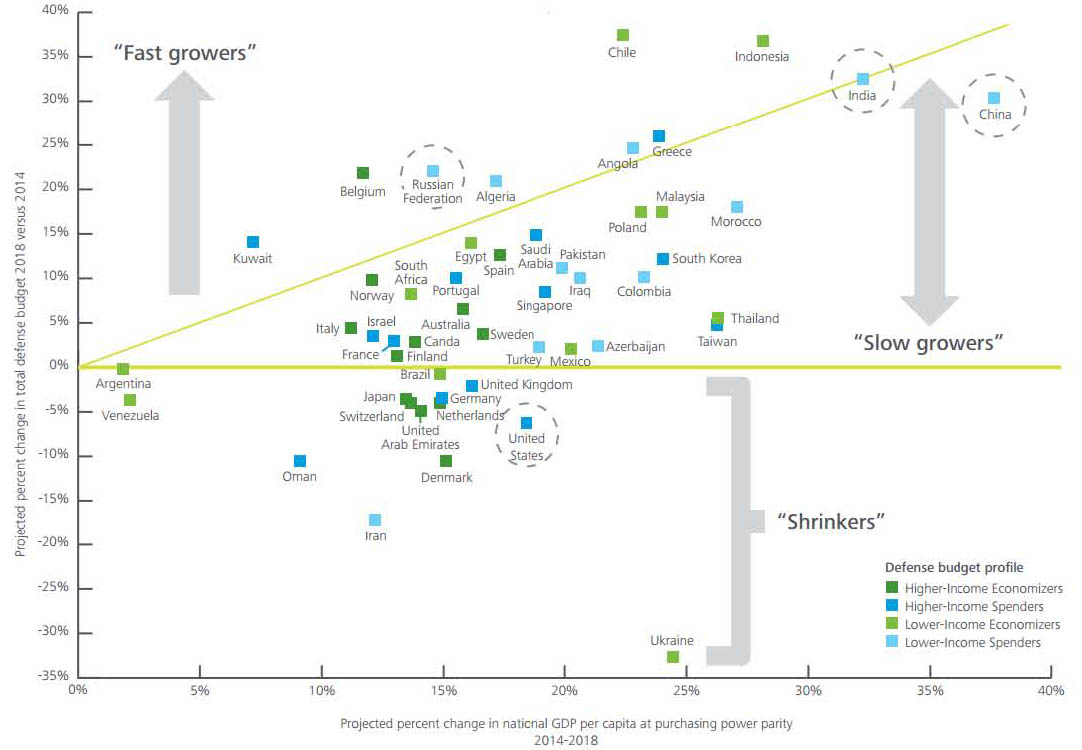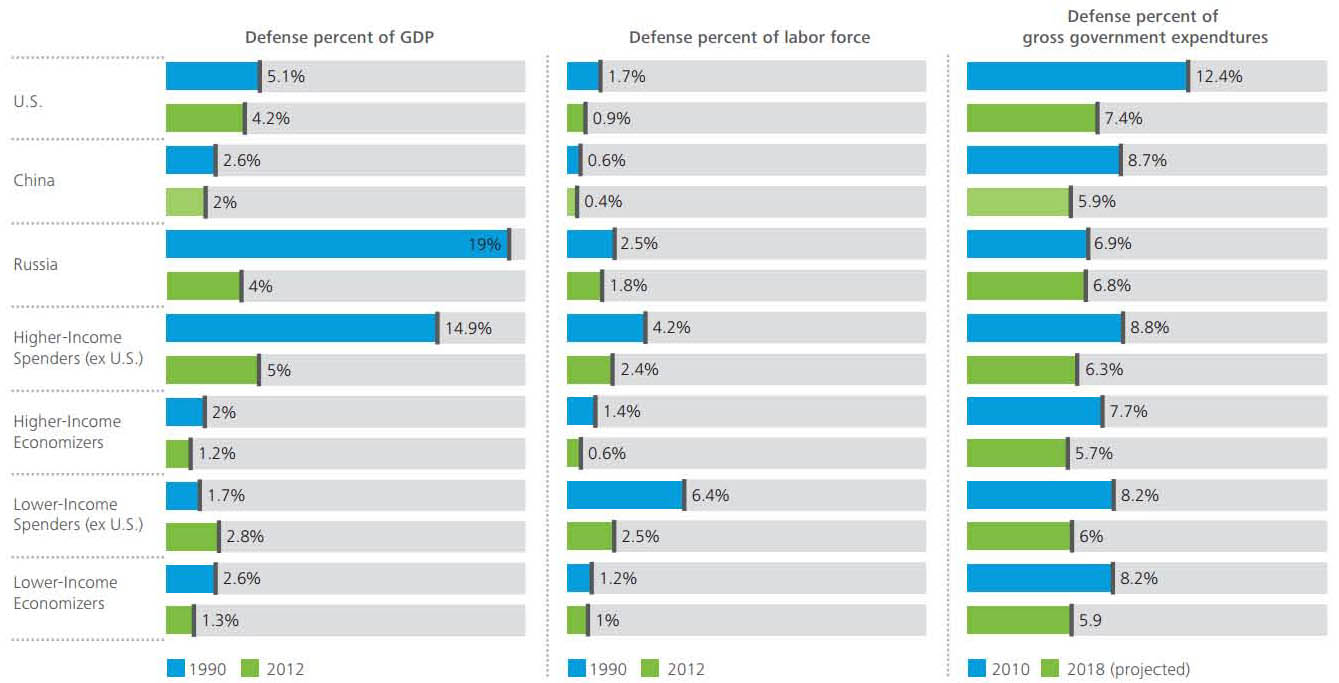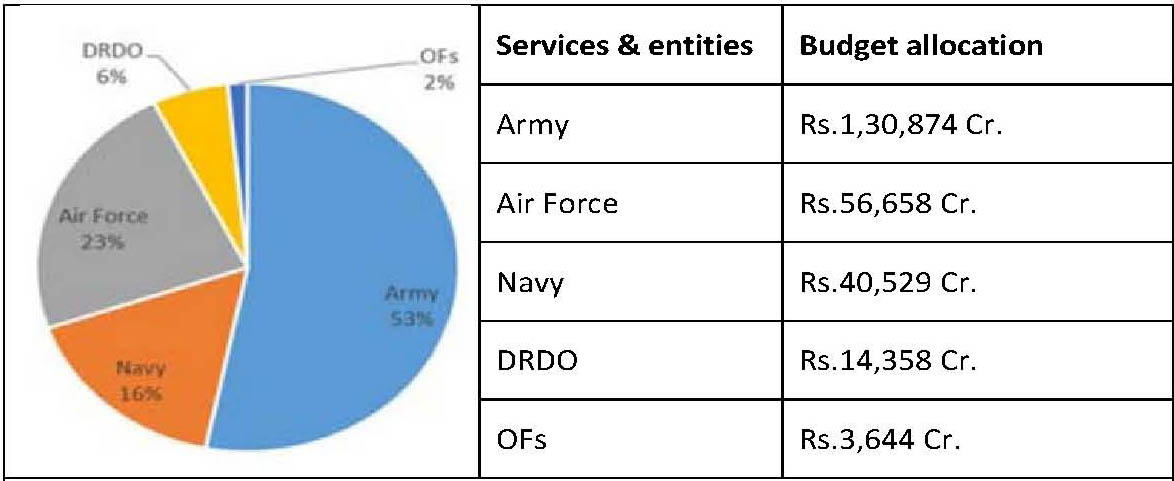Despite an ambitious increase in the FDI cap from 29% to 49%, Indian defence sector was not able to attract more than Rs.56 lakh as the FDI equity in flow during the period between October 2014 and September 2015. Some radical changes are expected to be made by defence ministry in its offsets policy, however, this year the industry is not just seeking funds but also in-depth R&D and access to latest technologies, as quick obsolescence of technology is sort of a default setting for a demanding sector like defence.
India is the Lower-Income Spender
Lower-Income Spenders (LISs) are the nations with GDP below $20,000 and percentage of GDP allocation to defence above 2%. According to Deloitte’s Global Defence Outlook 2015 – Defence and Development report, an independent report, India falls under the slab of LISs and shows great promise as a ‘Fast grower’ in total defence budget 2018 versus 2014.
*Deloitte analysed top 50 nations and categorized in its report as the Higher-Income (GDP per capita above $20,000) or the Lower-Income (GDP per capita below $20,000), and as a Spender (percentage of GDP that is allocated to the defence is above 2%) or an Economizer (below 2%).
It further elaborates interesting trends of non-U.S. Higher-Income nations who have been limiting the procurement budgets while the Lower-Income nations doing the exact opposite and reported building their defence industrial bases.
Defence ministries across all nations have emerging challenges and difficult decisions to make while levelling with the accelerating economic development and global defence industry shift.
How will India Play as the Defence Budget Growth Shifts to Asia?
India aspires to reach at 70% self-sufficiency level from domestic sources which has somehow remained around 30% since 1995. Inadequate investment in R&D, technological inefficiency, inability to manufacture major components, complicated approval policies are few of the most critical factors that were keeping India from becoming one of the self-reliant nations.
It is important to notice some equitable changes that Indian government has made in the current vendor policies as a part of Make in India initiative. It’s high-time to move up and go beyond Transfer of Technology (ToT), procure and manufacture here and better use the budget allocated for the cause.
FDI and Strategic Partnerships
Despite an ambitious increase in the FDI cap from 29% to 49%, Indian defence sector was not able to attract more than Rs.56 lakh as the FDI equity in flow during the period between October 2014 and September 2015. Some radical changes are expected to be made by defence ministry in its offsets policy, however, this year the industry is not just seeking funds but also in-depth R&D and access to latest technologies, as quick obsolescence of technology is sort of a default setting for a demanding sector like defence.
A huge array of possibilities for private strategic partnerships in defence, divided into 2 groups – the deals related to submarines, helicopters, aircraft and armoured vehicles in Group 1 and ammunition in Group 2, will strengthen the in-house manufacturing sector.
The Defence Procurement Procedure (DPP) of 2016, which has replaced blacklisting by “penal provisions,” is to work towards weeding out the entities holding the overall development back until now. The increase in contract threshold from Rs.300 Cr. to Rs.2, 000Cr. for offsets has been approved by DPP. Acceptance of Necessity (AoN) validity has also been brought down to six months from earlier one year which pushes the forces to optimise and issue tenders faster.
As a part of the new policy, many fundamental changes have been made keeping the strategic partnerships in mind by and a new category called Indigenously Designed, Developed and Manufactured (IDDM) has also been created by DPP. The changed L1 policy of selecting lowest bidder, funding allocation to the Indian private companies for R&D, provision of entry to MSMEs into defence production, provided they meet a certain rating benchmark. Indigenous production will steer under public-private partnerships and under joint-ventures with the Boeing and Lockheed of the world. This certainly looks like a good sign for a better future of defence industry.
A huge array of possibilities for private strategic partnerships in defence, divided into 2 groups – the deals related to submarines, helicopters, aircraft and armoured vehicles in Group 1 and ammunition in Group 2, will strengthen the in-house manufacturing sector. The organisation of Groups and resulting obstructions have made corporates quite unhappy, though.
Boeing and Tata announced JV to start manufacturing aero-structures for the Apache helicopter in India…
Quick summary of a few prominent deals signed in 2015 which are expected to push in 2016:
- India to buy 36 Rafale Fighter Jets in fly-away conditions from France
- Aequs signs pact in order to supply component’s for Boeing’s Chinook helicopter
- Rostec from Russia is to form JV with HAL and make Kamov 226T choppers
- L&T outguns its global rivals and bags Rs.5,000 crore deal from the Indian army
- Airbus and Mahindra are forming a JV to manufacture military helicopters
- Boeing and Tata announced JV to start manufacturing aero-structures for the Apache helicopter in India
- BAE Systems offers to manufacture ‘ultra-light’ guns in India
Few noticeable waves from the nations supporting India early in 2016
- Benjamin “Bibi” Netanyahu, the current Prime Minister of Israelis in favour of the mutual cooperation to encourage joint research & development, transfer of advanced high technology and manufacturing, and expanding relations in education.
- Chief of Naval operations of US navy Admiral John Richardson, during his visit to India, threw light on many focus areas of cooperation between the two navies, main being the exchange of information and the bilateral and multilateral exercises that will help improve the exchange of information at the field level.
- Post Indian PM Narendra Modi’s talks with Russian President Vladimir Putin in Moscow, both sides confirmed the intention to expand their scope of cooperation in design, development and production of high-technology military equipment and the strategic partnership on the nuclear front.
…we are definitely headed right way to achieve self-reliance in defence procurement and manufacturing.
And finally, straight from the horse’s mouth
Earlier this month, RM Manohar Parrikar said that “So, Rs. 2 lakh Cr. worth defence deals have been cleared during the current NDA government’s tenure. There are Rs. 75-80,000 Cr. worth capital acquisitions in defence. If you take still more decisions, then you won’t be left with money to pay. I’m quite a good budget planner, and we are planning for acquisitions over the next 10 years. So overall, we are one step ahead, and not behind.”
Which makes us believe that strategic partnerships are to play a big role in Make in India in 2016, the forces will receive almost all made in India arms and ammunitions in near future and we are definitely headed right way to achieve self-reliance in defence procurement and manufacturing.
References:
1. Deloitte’s Global Defence Outlook 2015 – Defence and Development, https://www2.deloitte.com/content/dam/Deloitte/global/Documents/Public-Sector/gx-2015-deloitte-global-defense-outlook.pdf.
This classification in the above report produces four Defence Budget Profiles, comprised of the following nations:
• Higher-Income Spenders: France, Greece, Israel, South Korea, Kuwait, Oman, Portugal, Saudi Arabia, Singapore, Taiwan, United Arab Emirates, United Kingdom, and the United States.
• Higher-Income Economizers: Australia, Belgium, Canada, Denmark, Finland, Germany, Italy, Japan, Netherlands, Norway, Spain, Sweden, and Switzerland.
• Lower-Income Spenders: Algeria, Angola, Azerbaijan, China, Colombia, India, Iran, Iraq, Morocco, Pakistan, Russia, Turkey, and Ukraine.
• Lower-Income Economizers: Argentina, Brazil, Chile, Egypt, Indonesia, Malaysia, Mexico, Poland, South Africa, Thailand, and Venezuela.
2. India’s Defence Budget 2015-16 by IDSA, http://www.idsa.in/issuebrief/IndiasDefenceBudget2015-16_lkbehera_020315.
3. 2015 a mixed year for defence FDI & ‘Make in India’; will 2016 be better for the sector? http://economictimes.indiatimes.com/news/defence/2015-a-mixed-year-for-defence-fdi-make-in-india-will-2016-be-better-for-the-sector/articleshow/50404690.cms.
4. India and Israel have a lot to gain from cooperation in research and development, http://www.defencenews.in/article/India-and-Israel-have-a-lot-to-gain-from-cooperation-in-research-and-development-2649.
5. “Make in India” not an obstacle to defence ties, says US navy chief, http://www.defencenews.in/article/%E2%80%98Make-in-India%E2%80%99-not-an-obstacle-to-defence-ties,-says-US-Navy-chief-2653.
6. No delay in arms deals, Defence Minister of India, Manohar Parrikar, http://www.defencenews.in/article/No-interference-from-PMO,-no-delays-in-arms-deals-Defence-Minister-Manohar-Parrikar-in-Aap-Ki-Adalat-2650.
7. New defence procurement procedure of push ‘Make in India’ initiative, http://www.dnaindia.com/india/report-new-defence-procurement-procedure-to-push-make-in-india-initiative-2164811.
8. 2015 a mixed year for defence FDI, http://www.defencenews.in/article/2015-a-mixed-year-for-defence-FDI-and-Make-in-India;-will-2016-be-better-for-the-sector-1752.









The quick summary of a few prominent deals gives the lie to this article. When the author mixes places “unsure deals” in that list, her entire thesis is blown to bits. This is actually a BIG attitude and perception problem in the whole of India. When India “decides” to do something, or “plans” to do something, Indians think it has been done. Nothing can be more ridiculous.
thank you a great deal for giving such a grate article i really
have grate usage of this specific article and valued in your case
do the job by way of thanking a person
National Security: (Defence preparedness and equipment): Essentially, the train that left the platform while Nehru chatted with the Station Master and eyed low hanging girls, picked up speed during the decade of the “parivar-that-loots-together-to-stay-together” (You Pay 1 & 2). “Make in India” is not a guarantee of either probity or effective weapons acquisition and is no better than any other Reservations-Corruption Raj Public Sector as we gleaned from “Tatra Trucks” Right now, what the BJP demands, however legitimate are more than most partners may concede. Technology plus investment plus long term commitment.
Further, there is the matter of who is a “reliable”, “strategic” partner. This needs to be given deep thought. It would be stupid to imagine that any foreign power would put Indian interests above their own. Least of all countries allied to india’s enemies of Islam and Communism (which includes China, the United States and all their camp followers). Essentially, such an analysis will show that for a country of India’s enormous size, economic insignificance and extreme weakness and vulnerability, there can be no “partners”. There is no escaping from the need for self reliance. This requires an objective and apolitical analysis of what stopped India from being a super power and fixing it. India was a Great Power in 1957 well above Germany, Japan, Singapore, and most of Western Europe, when it swaggered into Korea to enforce the truce between the US and China and Nehru refused the Permanent Membership of the UN Security Council. Today, India is near the bottom of the dung heap and below Sub-Saharan Africa at 135 out of 172 countries in Human and Social Development and at 143 out of 172 countries in Internal Peace and Stability. (UNDP Statistics 2015)
India’s Private Sector cannot pull India out of this morass either. It is very much stuck in the same morass and is subject to the same inferior thinking lack of standards, corruption and general Indi
Very well written, indepth article….